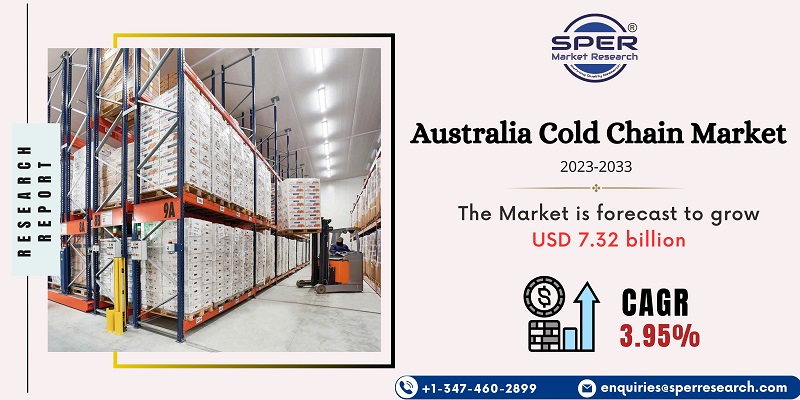
Australia Cold Chain Market Trends, Share, Size, Revenue, Scope, Challenges and Future Scope 2033
Australia Cold Chain Market Growth, Size, Trends Analysis- By Service, By Temperature Type, By Application- Regional Outlook, Competitive Strategies and Segment Forecast to 2033
| Published: Oct-2023 | Report ID: AMIN23158 | Pages: 1 - 104 | Formats*: |
| Category : Automotive & Transportation | |||
- July 2022: A new customer and an extra USD 160 million investment in its cutting-edge facility in Victoria were announced by NewCold, a pioneering Dutch cold chain logistics company, bringing its total investment in Victoria to USD 460 million. The size of NewCold's Melbourne 2 facility will more than double, giving consumers access to a wealth of cutting-edge capabilities and an effortless experience. The site will expand by 110,000 pallets, or 43 metres, from 115,000 to 225,000 pallet locations.
- March 2022: New Rotational Moulded Shippers were introduced by Global Cold Chain Solutions. As a result of the shipper's highly effective vacuum-insulated panel (VIP) insulation, temperatures can be maintained for up to eight days. Currently, there are two sizes of RotoMoulded Shippers available: 24L and 48L, with internal cargo capacities of 8L and 15L, respectively. The ships' ability to sustain temperatures between 2°C and 8°C for up to 201 hours is more than twice as long as that of competing models.


| Report Metric | Details |
| Market size available for years | 2019-2033 |
| Base year considered | 2022 |
| Forecast period | 2023-2033 |
| Segments covered | By Service, By Temperature Type, By Application |
| Regions covered | Eastern Region, Northern Region, Southern Region, Western Region |
| Companies Covered | AGRO Merchants Group, LLC, Americold Logistics, Auscold Logistics PTY Ltd., AustraCold*, Global Cold Chain Solutions, Karras Cold Logistics, Kerry Logistics, MFR Cool Logistics, NewCold Advanced Cold Logistics, PakCan, Others |
- Agricultural Sector
- Cold Storage and Logistics Providers
- Food Manufacturers and Processors
- Food Service Providers
- Government and Regulatory Bodies
- Importers and Exporters
- Pharmaceutical and Healthcare Industry
- Retailers and Distributors
- Others
| By Service: | |
| By Temperature Type: | |
| By Application: |
- Australia Cold Chain Market Size (FY’2023-FY’2033)
- Overview of Australia Cold Chain Market
- Segmentation of Australia Cold Chain Market By Service (Storage, Transportation, Value-added Services)
- Segmentation of Australia Cold Chain Market By Temperature Type (Chilled, Frozen)
- Segmentation of Australia Cold Chain Market By Application (Bakery and Confectionery, Dairy Products, Fruits and Vegetables, Meat and Seafood, Pharmaceuticals, Processed Food, Other Applications)
- Statistical Snap of Australia Cold Chain Market
- Expansion Analysis of Australia Cold Chain Market
- Problems and Obstacles in Australia Cold Chain Market
- Competitive Landscape in the Australia Cold Chain Market
- Impact of COVID-19 and Demonetization on Australia Cold Chain Market
- Details on Current Investment in Australia Cold Chain Market
- Competitive Analysis of Australia Cold Chain Market
- Prominent Players in the Australia Cold Chain Market
- SWOT Analysis of Australia Cold Chain Market
- Australia Cold Chain Market Future Outlook and Projections (FY’2023-FY’2033)
- Recommendations from Analyst
1.1. Scope of the report1.2. Market segment analysis
2.1. Research data source2.1.1. Secondary Data2.1.2. Primary Data2.1.3. SPER’s internal database2.1.4. Premium insight from KOL’s2.2. Market size estimation2.2.1. Top-down and Bottom-up approach2.3. Data triangulation
4.1. Driver, Restraint, Opportunity and Challenges analysis4.1.1. Drivers4.1.2. Restraints4.1.3. Opportunities4.1.4. Challenges4.2. COVID-19 Impacts of the Australia Cold Chain Market
5.1. SWOT Analysis5.1.1. Strengths5.1.2. Weaknesses5.1.3. Opportunities5.1.4. Threats5.2. PESTEL Analysis5.2.1. Political Landscape5.2.2. Economic Landscape5.2.3. Social Landscape5.2.4. Technological Landscape5.2.5. Environmental Landscape5.2.6. Legal Landscape5.3. PORTER’s Five Forces5.3.1. Bargaining power of suppliers5.3.2. Bargaining power of buyers5.3.3. Threat of Substitute5.3.4. Threat of new entrant5.3.5. Competitive rivalry5.4. Heat Map Analysis
6.1. Australia Cold Chain Market Manufacturing Base Distribution, Sales Area, Product Type6.2. Mergers & Acquisitions, Partnerships, Product Launch, and Collaboration in Australia Cold Chain Market
7.1. Australia Cold Chain Market Value Share and Forecast, By Service, 2023-20337.2. Storage7.3. Transportation7.4. Value-added Services
8.1. Australia Cold Chain Market Value Share and Forecast, By Temperature Type, 2023-20338.2. Chilled8.3. Frozen
9.1. Australia Cold Chain Market Value Share and Forecast, By Application, 2023-20339.2. Bakery and Confectionery9.3. Dairy Products9.4. Fruits and Vegetables9.5. Meat and Seafood9.6. Pharmaceuticals9.7. Processed Food9.8. Other Applications
10.1. Australia Cold Chain Market Size and Market Share
11.1. Australia Cold Chain Market Size and Market Share By Service (2019-2026)11.2. Australia Cold Chain Market Size and Market Share By Service (2027-2033)
12.1. Australia Cold Chain Market Size and Market Share By Temperature Type (2019-2026)12.2. Australia Cold Chain Market Size and Market Share By Temperature Type (2027-2033)
13.1. Australia Cold Chain Market Size and Market Share By Application (2019-2026)13.2. Australia Cold Chain Market Size and Market Share By Application (2027-2033)
14.1. Australia Cold Chain Market Size and Market Share By Region (2019-2026)14.2. Australia Cold Chain Market Size and Market Share By Region (2027-2033)14.3. Eastern Region14.4. Northern Region14.5. Southern Region14.6. Western Region
15.1. AGRO Merchants Group, LLC15.1.1. Company details15.1.2. Financial outlook15.1.3. Product summary15.1.4. Recent developments15.2. Americold Logistics15.2.1. Company details15.2.2. Financial outlook15.2.3. Product summary15.2.4. Recent developments15.3. Auscold Logistics PTY Ltd.15.3.1. Company details15.3.2. Financial outlook15.3.3. Product summary15.3.4. Recent developments15.4. AustraCold*15.4.1. Company details15.4.2. Financial outlook15.4.3. Product summary15.4.4. Recent developments15.5. Global Cold Chain Solutions15.5.1. Company details15.5.2. Financial outlook15.5.3. Product summary15.5.4. Recent developments15.6. Karras Cold Logistics15.6.1. Company details15.6.2. Financial outlook15.6.3. Product summary15.6.4. Recent developments15.7. Kerry Logistics15.7.1. Company details15.7.2. Financial outlook15.7.3. Product summary15.7.4. Recent developments15.8. MFR Cool Logistics15.8.1. Company details15.8.2. Financial outlook15.8.3. Product summary15.8.4. Recent developments15.9. NewCold Advanced Cold Logistics15.9.1. Company details15.9.2. Financial outlook15.9.3. Product summary15.9.4. Recent developments15.10. PakCan15.10.1. Company details15.10.2. Financial outlook15.10.3. Product summary15.10.4. Recent developments15.11. Others
SPER Market Research’s methodology uses great emphasis on primary research to ensure that the market intelligence insights are up to date, reliable and accurate. Primary interviews are done with players involved in each phase of a supply chain to analyze the market forecasting. The secondary research method is used to help you fully understand how the future markets and the spending patterns look likes.
The report is based on in-depth qualitative and quantitative analysis of the Product Market. The quantitative analysis involves the application of various projection and sampling techniques. The qualitative analysis involves primary interviews, surveys, and vendor briefings. The data gathered as a result of these processes are validated through experts opinion. Our research methodology entails an ideal mixture of primary and secondary initiatives.



Frequently Asked Questions About This Report
PLACE AN ORDER
Year End Discount
Sample Report
Pre-Purchase Inquiry
NEED CUSTOMIZATION?
Request CustomizationCALL OR EMAIL US
100% Secure Payment






Related Reports
Our Global Clients
Our data-driven insights have influenced the strategy of 200+ reputed companies across the globe.




















